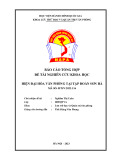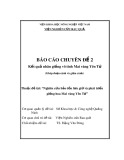
Open Access
Available online http://ccforum.com/content/11/4/R80
Page 1 of 7
(page number not for citation purposes)
Vol 11 No 4
Research
Staffing level: a determinant of late-onset ventilator-associated
pneumonia
Stéphane Hugonnet, Ilker Uçkay and Didier Pittet
Infection Control Program, University of Geneva Hospitals, Rue Micheli-du-Crest, 1211 Geneva 14, Switzerland
Corresponding author: Didier Pittet, didier.pittet@hcuge.ch
Received: 9 Mar 2007 Revisions requested: 15 May 2007 Revisions received: 8 Jun 2007 Accepted: 19 Jul 2007 Published: 19 Jul 2007
Critical Care 2007, 11:R80 (doi:10.1186/cc5974)
This article is online at: http://ccforum.com/content/11/4/R80
© 2007 Hugonnet et al.; licensee BioMed Central Ltd.
This is an open access article distributed under the terms of the Creative Commons Attribution License (http://creativecommons.org/licenses/by/2.0),
which permits unrestricted use, distribution, and reproduction in any medium, provided the original work is properly cited.
Abstract
Introduction The clinical and economic burden of ventilator-
associated pneumonia (VAP) is uncontested. We conducted
the present study to determine whether low nurse-to-patient
ratio increases the risk for VAP and whether this effect is similar
for early-onset and late-onset VAP.
Methods This prospective, observational, single-centre cohort
study was conducted in the medical intensive care unit (ICU) of
the University of Geneva Hospitals. All patients who were at risk
for ICU-acquired infection admitted from January 1999 to
December 2002 were followed from admission to discharge.
Collected variables included patient characteristics, admission
diagnosis, Acute Physiology and Chronic Health Evaluation II
score, co-morbidities, exposure to invasive devices, daily
number of patients and nurses on duty, nurse training level and
all-site ICU-acquired infections. VAP was diagnosed using
standard definitions.
Results Among 2,470 patients followed during their ICU stay,
262 VAP episodes were diagnosed in 209/936 patients
(22.3%) who underwent mechanical ventilation. Median
duration of mechanical ventilation was 3 days (interquartile
range 2 to 6 days) among patients without VAP and 11 days (6
to 19 days) among patients with VAP. Late-onset VAP
accounted for 61% of all episodes. The VAP rate was 37.6
episodes per 1,000 days at risk (95% confidence interval 33.2
to 42.4). The median daily nurse-to-patient ratio over the study
period was 1.9 (interquartile range 1.8 to 2.2). By multivariate
Cox regression analysis, we found that a high nurse-to-patient
ratio was associated with a decreased risk for late-onset VAP
(hazard ratio 0.42, 95% confidence interval 0.18 to 0.99), but
there was no association with early-onset VAP.
Conclusion Lower nurse-to-patient ratio is associated with
increased risk for late-onset VAP.
Introduction
Ventilator-associated pneumonia (VAP) is the most frequent
preventable adverse event affecting critically ill patients [1]. It
occurs in approximately 25% of patients undergoing mechan-
ical ventilation, for a rate of 4 to 25 episodes per 1,000 venti-
lator-days. Previous research has yielded conflicting results on
attributable mortality, and reports range from 0% to as high as
70% [2-4]. VAP prolongs length of stay by up to 50 days,
duration of mechanical ventilation by 5 to 7 days, and gener-
ates substantial extra costs, in the order of US$10,000 to
40,000 per episode [2,5,6].
Risk factors for VAP are still poorly understood and many have
been described, including reintubation, duration of mechanical
ventilation, intubation route, underlying pulmonary disease,
use of H2 blocking agents, timing of tracheotomy, failed sub-
glottic aspiration and low intracuff pressure [2,7,8]. Further-
more, the aetiopathogenesis of VAP has not been fully
elucidated, and there is much debate and research into the ori-
gin of the micro-organisms that are involved in VAP and con-
sequently into preventative measures [2,7-10].
At a time of universal cost containment policies, there is grow-
ing evidence that high workload or low staffing level increases
the risk for negative patient outcomes [11,12], such as death
[13] and nosocomial infection [12,14-16]. In a previous study
[17] we investigated the association between nurse workload
and infection risk in a medical intensive care unit (ICU) [17].
We estimated that a higher nurse-to-patient ratio was associ-
ated with a 30% risk reduction for all ICU-acquired infections,
APACHE = Acute Physiology and Chronic Health Evaluation; CI = confidence interval; HR = hazard ratio; ICU = intensive care unit; IQR = interquar-
tile range; VAP = ventilator-associated pneumonia.

Critical Care Vol 11 No 4 Hugonnet et al.
Page 2 of 7
(page number not for citation purposes)
and that maintaining a nurse-to-patient ratio above 2.2 would
ultimately lead to avoidance of a large proportion of all infec-
tions (population attributable fraction 26.7%).
The present work extends the former study by focusing on the
main infection that occurs in the ICU, namely pneumonia, with
the aim to determine whether workload influences the risk for
VAP and whether this effect is similar for early-onset and late-
onset VAP.
Materials and methods
Setting and study design
This prospective observational cohort study was conducted in
the medical ICU of the University of Geneva Hospitals. The
study design has been reported elsewhere [17]. In brief, all
patients admitted from January 1999 to December 2002 were
followed from admission to discharge. Collected variables
included patient characteristics, admission diagnosis, Acute
Physiology and Chronic Health Evaluation (APACHE) II score
[18], length of stay, comorbidities and Charlson index [19],
daily exposure to invasive devices, daily number of patients
and nurses on duty, nurse training level, all-site nosocomial
infections and daily individual PRN (Projet de Recherche en
Nursing; a surrogate for the nursing acuity score) [20]. The
protocol for preventing VAP remained unchanged throughout
the study period.
Definition of ventilator-associated pneumonia
Pneumonia was defined according to modified criteria pro-
posed by the US Centers for Disease Control and Prevention
[21-24]. This definition requires two of the following criteria to
be satisfied: fever (increase of ≥ 1°C or body temperature >
38.3°C); leucocytosis (25% increase and a value ≥ 10,000
mm3), or leukopenia (25% decrease and a value ≤ 5,000
mm3); and purulent tracheal secretions (> 25 neutrophils per
high-power field). It also requires one of the following to be
satisfied: new and persistent infiltrates on chest radiograph;
same micro-organism isolated from pleural fluid and tracheal
secretions, or radiographic cavitation, or histological proof of
pneumonia; or positive cultures from bronchoalveolar lavage
(≥ 104 colony-forming units/ml). Pneumonia was considered to
be VAP if it occurred from the day following intubation to five
days after extubation. This period was deemed to be the time
at risk. VAP was defined as early-onset when it occurred one
to five days after intubation, and late-onset when it occurred
from day six. Respiratory infections other than VAP were
excluded from the analysis.
Definition and measurement of nurse-to-patient ratio
and other covariates
The way in which nurse-to-patient ratio was measured and
consolidated is described in a previous report [17]. The ratio
was determined by dividing the total number of nurses working
during a given day by the patient census for that day. Assum-
ing that the number of nurses per morning, evening and night
shift was 13, 8 and 7, respectively, and the patient census was
15, the 24-hour nurse-to-patient ratio was 1.9, and the mean
ratio per shift was 0.6 (1.9 divided by three shifts). We showed
in the same study that a lower staffing level on a given day was
associated with increased infection risk two to four days later.
For this reason, we allowed for a latent period between expo-
sure and outcome. Finally, because the precise time of con-
tamination is unknown and incubation periods vary, the daily
nurse-to-patient ratio for a given patient was consolidated as
the mean of the ratios of the two to four preceding days. Other
time-varying covariates (for instance, exposure to antibiotics)
were consolidated in the same way with respect to timing.
Consequently, exposures were allowed to change over time,
and the two days preceding the infection or the end of the at-
risk period were not considered.
Statistical analysis
Infection rates were reported as the number of episodes per
1,000 days at-risk, with corresponding 95% confidence inter-
vals (CIs), based on the Poisson distribution. Categorical var-
iables were compared by χ2 test; continuous variables were
compared using a nonparametric test. The association
between potential risk factors and infection was investigated
using time-dependent Cox regression models and summa-
rized by proportional hazard ratios (HRs) [25]. The main risk
factor was nurse-to-patient ratio, consolidated as described
above [17]. Patients without VAP were censored at the end of
the at-risk period. Only the first episode of VAP was consid-
ered in a single failure per subject analysis, and days after this
first episode were excluded from the time at-risk. The first anal-
ysis included all first episodes of VAP; the second analysis
included only early-onset VAP; and the last analysis included
only late-onset VAP. When failure was early-onset VAP,
patients with a late-onset VAP were excluded and vice versa.
Early-late and late-onset VAP were investigated in a univariate
and multivariate model, and only variables associated with a P
< 0.2 in univariate analysis were explored in multivariate anal-
ysis; only those with a P < 0.05 were considered statistically
significant and retained in the final model. We looked for a
threshold effect by categorizing the nurse-to-patient ratio in
four groups, the cutoff values being arbitrarily the 25th, 50th
and 75th percentiles of the ratio's distribution, and compared
models using the likelihood ratio test. Analyses were con-
ducted with STATA software (version 9.0; STATA Corp, Col-
lege Station, TX, USA).
Results
Of 2,470 patients followed during their ICU stay, 262 epi-
sodes of VAP were diagnosed in 209 out of 936 patients
(22.3%) who underwent mechanical ventilation. A total of 172
patients experienced one episode of VAP and 37 patients
experienced more than one episode. Late-onset infection
accounted for two-thirds of VAP (160/262 [61%]). The VAP
rate was 37.6 episodes per 1,000 days at risk (95% CI 33.2
to 42.4). The main characteristics of the study population are

Available online http://ccforum.com/content/11/4/R80
Page 3 of 7
(page number not for citation purposes)
presented in Table 1. Compared with patients who did not suf-
fer VAP, those with VAP stayed significantly longer in the ICU
and required mechanical ventilatory support for a longer
period. ICU mortality rates among patients with and those
without VAP were 33.5% and 31.2%, respectively (P = 0.54),
whereas hospital mortality rates were 45.0% and 39.5% (P =
0.154).
Microbiological documentation of the infection was obtained
for 177 episodes (68%) in which 271 micro-organisms were
identified; 74 infections (28.2%) were polymicrobial. The lead-
ing pathogens are summarized in Table 2.
The median daily nurse-to-patient ratio over the study period
was 1.9, and ranged from 1.4 to 5.3 (interquartile range [IQR]
1.8 to 2.2). The median (IQR) ratios during the morning,
evening and night shifts were 0.8 (0.7 to 0.9), 0.6 (0.5 to 0.7)
and 0.6 (0.5 to 0.6), respectively. The median (IQR) nurse-to-
patient ratio for a given patient was 2.0 (1.9 to 2.1) and the
median (IQR) minimum and maximum values were 1.7 (1.6 to
1.8) and 2.3 (2.1 to 2.6), respectively. The crude HR (95% CI)
of nurse-to-patient ratio 2 to 4 days before VAP onset was
0.64 (0.39 to 1.06) for all VAP episodes, 0.77 (0.42 to 1.40)
for early-onset VAP episodes, and 0.43 (0.18 to 1.02) for late-
onset VAP episodes. Results were similar in multivariate anal-
ysis for all VAP episodes (adjusted HR 0.66, 95% CI 0.40 to
1.10) and early-onset VAP episodes (adjusted HR 0.78, 95%
CI 0.42 to 1.45). In multivariate analysis, higher nurse-to-
patient ratio was associated with a reduced risk for late-onset
VAP (adjusted HR 0.42, 95% CI 0.18 to 0.99). We identified
no interaction between staffing level and nurses' training level.
Neither the nurse training level nor the APACHE II score at
admission had an effect on the hazard of VAP; the nursing acu-
ity score at admission increased infection risk (Table 3).
Table 1
Characteristics of the study population
Characteristic Total population Patients with VAP Patients without VAP
Number of patients 936 209 727
Age (years) 65 (50 to 75) 64 (54 to 74) 65 (48 to 75)
Male sex 552 (59.0) 125 (59.8) 427 (58.7)
Charlson score at admissiona
0 335 (35.8) 69 (33.0) 266 (36.6)
1 to 2 326 (34.8) 91 (43.5) 235 (32.3)
3 to 5 184 (19.7) 34 (16.3) 150 (20.6)
> 5 91 (9.7) 15 (7.2) 76 (10.5)
APACHE II score at admissionb
< 26 367 (40.3) 74 (37.2) 293 (41.2)
26 to 30 170 (18.7) 37 (18.6) 133 (18.7)
> 30 373 (41.0) 88 (44.2) 285 (40.1)
Nursing acuity score at admission 226 (199 to 226) 226 (200 to 226) 226 (196 to 226)
Admission diagnosis
Infectious diseasea238 (25.4) 70 (33.5) 168 (23.1)
Cardiovascular condition 315 (33.7) 76 (36.4) 239 (32.9)
Pulmonary disease 139 (14.9) 27 (12.9) 112 (15.4)
Othera244 (26.1) 36 (17.2) 208 (28.6)
ICU stay (days)a6 (3 to 11) 15 (10 to 23) 5 (3 to 8)
Duration of mechanical ventilation (days)a3 (2 to 8) 11 (6 to 19) 3 (2 to 6)
ICU mortality 297 (31.7) 70 (33.5) 227 (31.2)
Hospital stay (days)a18 (7 to 38) 29 (17 to 67) 14 (5 to 32)
Hospital mortality 381 (40.7) 94 (45.0) 287 (39.5)
Values are expressed as numbers (%) or median (interquartile range) for continuous variables. aSignificant difference between patients with and
without VAP (P < 0.05). bTwenty-six missing values. APACHE, Acute Physiology and Chronic Health Evaluation; ICU, intensive care unit; VAP,
ventilator-associated pneumonia.

Critical Care Vol 11 No 4 Hugonnet et al.
Page 4 of 7
(page number not for citation purposes)
We then investigated a threshold effect of staffing level on the
risk for late-onset VAP. We used the same adjustment varia-
bles as shown in Table 3 and categorized the nurse-to-patient
ratio into four groups (≤ 1.8, 1.8 to ≤ 1.9, 1.9 to 2.2, and >
2.2), using the first group as baseline. The adjusted HRs (95%
CIs) were 0.70 (0.41 to 1.18), 0.59 (0.36 to 0.95) and 0.54
(0.28 to 1.02), respectively, indicating a dose-response trend
but no clear threshold. The fit of both models (using the staff-
ing level as a continuous or a categorical variable) were similar
(likelihood ratio test; P = 0.62).
Discussion
This study confirms the high frequency of VAP in critical care
and its negative impact on patient outcomes and resource uti-
lization [5,6]. More importantly, our data contribute to a better
understanding of the determinants of VAP. We demonstrated
that a lower nurse staffing level increases the risk for late-onset
VAP, independent of confounding factors (such as length of
ICU stay or APACHE II score at admission), but it does not
influence the occurrence of early-onset VAP.
We hypothesize that increased workload results in noncompli-
ance with basic hygiene measures and infection control rec-
ommendations. During the past two decades, the number of
nurses has decreased almost worldwide, whereas the level of
patient acuity has increased [4,16]. Time constraints can
increase the probability of error by creating a busy, stressful
environment with distractions and interruptions [26], leading
to low compliance with hand hygiene recommendations [27]
and isolation procedures, or inadequate care for the ventilated
patient. Cross-transmission of micro-organisms from one
patient or the environment to another patient, or from one body
site to another in the same patient, leads to colonization and
infection. Because a large proportion of early-onset pneumo-
nia results from early aspiration, it was not expected that staff-
ing level would influence its occurrence. The observation that
lower staffing level increases the risk for late-onset VAP is con-
sistent with the multiple opportunities for cross-transmission
during the course of patient care [28].
Although the need to specify critical nurse-to-patient ratios
has grown in importance in health care research [29], there is
no clear-cut staffing level threshold above which the infection
risk decreases because the relationship between nurse-to-
patient ratio and infection risk seems rather linear, as indicated
in the present study and another one that was recently
reported [17]. Indeed, there cannot be a single and unique
threshold because the optimal staffing level depends on both
risk and costs. Although the number of studies investigating
the association between staffing level and preventable
adverse outcomes is growing rapidly, few show how many or
what proportion of infections could be prevented if the staffing
level were modified, and to the best of our knowledge only
three specifically examined healthcare-associated pneumonia.
Two studies conducted in surgical ICUs [30,31] identified a
significant increase in VAP and reintubation rates and costs if
the nurse-to-patient ratio was below 0.5. Outside the ICU set-
ting, an increase by one hour worked by registered nurses was
associated with an 8.9% decrease in nosocomial pneumonia
[32]. We recently reported that more than 20% of all-site ICU-
acquired infections could be prevented, provided that the
nurse-to-patient ratio was maintained above 2.2 [17].
Our study provided other interesting results. First, for several
reasons, our VAP rate is higher than is usually found in the lit-
erature. Our surveillance system is prospective, on-site and
consequently sensitive [33,34]; our case definition does not
rely only on invasive diagnostic techniques; and the first two
days following insertion of the endotracheal tube were
excluded from the denominator because the patient, strictly
Table 2
Distribution of leading pathogens in patients with ventilator-
associated pneumonia
Details regarding episodes of infection Total (%)a
Number of episodes microbiologically documented 177
Number of microorganisms identified 271
Gram-negative microorganisms 140 (52)
Pseudomonas aeruginosa 25 (9)
Enterobacter spp. 20 (7)
Escherichia coli 17 (6)
Klebsiella pneumoniae 15 (6)
Proteus mirabilis 7 (3)
Haemophilus influenzae 6 (2)
Non-aeruginosa Pseudomonas spp. 6 (2)
Serratia marcescens 5 (2)
Other Gram-negative micro-organismsb39 (14)
Gram-positive microorganisms 75 (28)
Staphylococcus aureus 55 (20)
Coagulase-negative staphylococci 10 (4)
Enterococus faecalis 3 (1)
Streptococcus pneumoniae 2 (1)
Other streptococci 2 (1)
Other Gram-positive micro-organisms 3 (1)
Other micro-organisms 56 (21)
Candida albicans 34 (13)
Non-albicans Candida spp. 6 (2)
Other micro-organismsc16 (6)
aThe percentage given is that of the total number of micro-organisms
(n = 271). bOther Gram-negative microorgamisms included other
enterobacteriaceae, Acinetobacter spp., Citrobacter spp., other
Klebsiella spp. and Morganella morgani. cOther micro-organisms
include fungi and viruses.

Available online http://ccforum.com/content/11/4/R80
Page 5 of 7
(page number not for citation purposes)
speaking, is not at risk during these days. We previously high-
lighted the critical importance of the denominator in correctly
expressing VAP rates [35]. Unlike others [36,37], we found no
association between infection risk and nurses' training level,
probably because we do not have recourse to 'pool' or 'float'
nurses in the ICU. Interestingly, exposure to a peripheral vas-
cular line was associated with an increased risk for infection.
This should be considered a surrogate marker of severity of
disease; the most severely ill patients will remain on the venti-
lator for a longer time and will be more likely to be exposed to
several intravascular devices, including peripheral lines. We
have no clear explanation for why patients admitted with a pul-
monary disease experienced a lower VAP risk; one possibility
is that a large proportion of these patients were ventilated for
a short time for diseases such as asthma.
Our study suffers from some limitations. First, it was con-
ducted in a single medical ICU, thus limiting the generalizabil-
ity of the results. Second, we did not perform genotyping of
microbial isolates to assess further the level of cross-transmis-
sion. Third, details of some process indicators that might have
an adverse influence because of a lower staffing level (for
instance, head positioning) were not routinely recorded.
Fourth, as for any study on this topic, the challenge of accu-
Table 3
Risk factors for ventilator-associated pneumonia: crude and adjusted effect of staffing level
Risk factor Early-onset VAP Late-onset VAP
Crude HR (95% CI) Adjusted HR (95% CI) Crude HR (95% CI) Adjusted HR (95% CI)
Nurse-to-patient ratio 0.77 (0.42 to 1.40) 0.78 (0.42 to 1.45) 0.43 (0.18 to 1.02) 0.42 (0.18 to 0.99)
Patient age 1.00 (0.99 to 1.01) - 1.00 (0.99 to 1.01) -
Male gender 0.92 (0.62 to 1.38) - 1.15 (0.79 to 1.69) -
Nursing acuity severity score 0.96 (0.92 to 1.01) - 1.03 (1.00 to 1.07) 1.04 (1.00 to 1.08)
Charlson score 0.89 (0.81 to 0.99) 0.89 (0.80 to 0.98) 0.96 (0.87 to 1.05)
Admission diagnosis
Infectious disease 0.75 (0.46 to 1.20) - 1.09 (0.75 to 1.60) -
Cardiovascular condition 1.63 (1.10 to 2.41) - 1.47 (0.97 to 2.23) -
Pulmonary disease 0.77 (0.44 to 1.33) - 0.56 (0.31 to 1.02) 0.53 (0.29 to 0.97)
Other 0.87 (0.53 to 1.41) - 0.84 (0.49 to 1.43) -
APACHE II score
< 26 1 - 1 -
26 to 30 1.12 (0.67 to 1.86) - 0.92 (0.49 to 1.72) -
> 30 0.83 (0.53 to 1.31) - 1.08 (0.70 to 1.67) -
Nursing training levela0.84 (0.60 to 1.18) - 1.19 (0.91 to 1.56) -
Invasive devices
Central vascular line 1.50 (0.92 to 2.45) 1.71 (1.05 to 2.81) 3.06 (0.97 to 9.70) 4.14 (1.26 to 13.55)
Peripheral venous line 2.06 (0.76 to 5.61) - 1.47 (0.95 to 2.29) 1.65 (1.06 to 2.59)
Peripheral arterial line 0.58 (0.32 to 1.06) - 5.65 (0.78 to 40.84) -
Urinary catheter 1.86 (0.66 to 5.26) - 1.31 (0.41 to 4.16) -
Nasogastric tube 1.40 (0.75 to 2.63) - 2.39 (0.76 to 7.54) -
Medication
Parenteral nutrition 0.83 (0.49 to 1.41) - 0.99 (0.65 to 1.51) -
Therapeutic antibiotic 0.48 (0.32 to 0.73) 0.47 (0.31 to 0.71) 0.51 (0.29 to 0.91) 0.34 (0.19 to 0.62)
Prophylactic antibiotic 0.58 (0.18 to 1.84) - 1.22 (0.56 to 2.63) -
Gastric antacid drug 1.34 (0.90 to 2.00) - 0.98 (0.66 to 1.46) -
aNursing training level is the number of intensive care unit certified nurses divided by the number of trainee nurses in critical care. APACHE, Acute
Physiology and Chronic Health Evaluation; CI, confidence intervals; HR, hazard ratio; VAP, ventilator-associated pneumonia.




![PET/CT trong ung thư phổi: Báo cáo [Năm]](https://cdn.tailieu.vn/images/document/thumbnail/2024/20240705/sanhobien01/135x160/8121720150427.jpg)





















